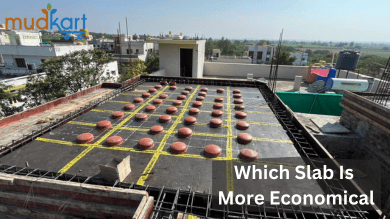Show cart summary 0 Items
Please Add Some Items
Which Slab is More Economical
- By Afia
- • Mar 11, 2024

Have you ever considered how cost-effective different types of construction slabs are? In India, a place where new ideas blend with old traditions, the construction industry is always changing to use materials and methods that are both eco-friendly and affordable.
One innovation, the filler slab, is becoming popular for its ability to save money. But why is it cheaper than traditional concrete slabs? Read on to learn more.
What are Traditional Concrete Slabs?
Traditional concrete slabs are a basic part of many buildings. They are made by mixing concrete with steel to make them strong. These slabs are very important for making the floors and ceilings of buildings strong and long-lasting.
But, even though they are used a lot, making them requires a lot of materials like concrete and steel, which can be expensive and not so great for the environment. This has made people look for other option
Introduction to Filler Slabs
Filler slabs are a new way to build that tries to use less concrete and steel, which are usually the most expensive parts of building slabs.
This method is about using different, environmentally friendly materials such as clay pots, special tiles, or even stuff that has been thrown away to fill in parts of the slab. These parts are where the concrete's strength for holding things up isn't needed.
The main point of filler slabs is understanding that the bottom half of a slab, which usually only deals with forces that pull on it, doesn't need to be filled with concrete if there's enough support to handle these pulling forces.
This idea helps save on materials and costs, making it an attractive option for building in a more economical and environmentally friendly way.
Cost-Benefit Analysis of Filler Slabs
Filler slabs are a smart choice not just because they use less concrete and steel, but also because they can save money. On average, buildings that use filler slabs spend about 20% less compared to those with regular concrete slabs.
This saving is mainly because filler slabs use cheaper materials to fill in some areas and need less steel and concrete.
This method not only makes building cheaper but also helps the environment. By using filler slabs, the carbon footprint of a building can go down by around 20%. This means buildings that use filler slabs are not just saving money but are also better for the planet.
Factors Influencing Slab Choice
Choosing the best slab for construction is very important. It affects how much the project costs, how long it takes, how long the building lasts, and how well it works.
There are several important factors to consider when making this choice:
Material Availability
What materials are available can greatly influence the decision. For filler slabs, using materials like clay pots, coconut shells, or recycled items can cut down on how much concrete and steel is needed.
If these materials are easy to get locally, it can reduce costs for transportation, making filler slabs an attractive option. However, in places where these materials are hard to find or costly, traditional concrete slabs might be a better choice, even if they use more materials.
Structural Requirements
The building's structural needs are key. Traditional concrete slabs are strong and good for buildings that need to support a lot of weight.
Filler slabs can be efficient too but might not be the best for all buildings, especially those expected to carry heavy loads. The building's design and purpose should help decide which slab type is best, ensuring it meets safety and structural standards.
Environmental Impact
How much a project affects the environment is also a big factor. Filler slabs are seen as more environmentally friendly because they use less concrete and steel and can include recycled materials. They're a good choice for projects that want to be green or prioritize being eco-friendly.
Aesthetic and Thermal Considerations
How a building looks and its temperature control is important too. Filler slabs can make a ceiling look unique and interesting by showing the filler materials. They can also help keep a building cooler, which is great in warm climates.
Each of these factors needs to be considered carefully to choose the right slab for a construction project.
Final Thoughts
Filler slabs present an attractive option over conventional concrete slabs for those aiming for cost-effective and eco-friendly construction. Knowing the advantages and factors associated with filler slabs enables builders and homeowners to choose in line with their priorities and needs.
To discover more creative building methods and materials, Mudkart is a great resource, blending sustainability with cost savings in construction.
Tags: Filler Slab, Mudkart

0 Comment